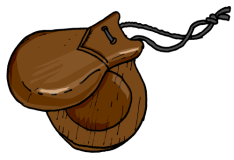castanets (Pair of concave shells)
~ Percussion instrument
Description
Pair of concave wood, bone, shell or even fibreglass shells, they are combined by a string and are often used by dancers.
Wikipedia
Castanets, also known as clackers or palillos, are a percussion instrument (idiophone), used in Spanish, Calé, Moorish, Ottoman, Italian, Mexican, Sephardic, Portuguese and Swiss music. In ancient Greece and ancient Rome there was a similar instrument called the crotalum.
The instrument consists of a pair of concave shells joined on one edge by a string. They are held in the hand and used to produce clicks for rhythmic accents or a ripping or rattling sound consisting of a rapid series of clicks. They are traditionally made of hardwood (chestnut; Spanish: castaño), although fibreglass has become increasingly popular.
In practice, a player usually uses two pairs of castanets. One pair is held in each hand, with the string hooked over the thumb and the castanets resting on the palm with the fingers bent over to support the other side. Each pair will make a sound of a slightly different pitch. The slightly lower one usually marks the beat with joined fingers, whereas the slightly higher one is used for variations with all four fingers, including producing rattle-like sounds.
The origins of the instrument are not confirmed. The practice of clicking hand-held sticks together to accompany dancing is ancient, and was practiced by both the Greeks and the Egyptians. Most sources relate its historical origins and spread to the Phoenicians travelling and trading throughout the Mediterranean around 3000 years ago, with strong trade relations with what is now Spain. Origins further back in Ancient Egypt (which knew castanet-like instruments made of wood, ivory, and metal) are deemed probable. According to sources, Ancient Romans encountered this instrument among the indigenous population (Iberians and others) of Hispania, already around 200 BC. It soon obtained an important role in folk music in various parts of Spain. In more modern times, the bones and spoons used in Minstrel show and jug band music can also be considered forms of the castanet.
During the Baroque period, castanets featured prominently in dances. Composers like Jean-Baptiste Lully scored them for the music of dances which included Spaniards (Ballet des Nations), Egyptians (Persée, Phaëton), Ethiopians (Persée, Phaëton), and Korybantes (Atys). In addition, they are often scored for dances involving less pleasant characters such as demons (Alceste) and nightmares (Atys). Their association with African dances is even stated in the ballet Flore (1669) by Lully, "... les Africains inventeurs des danses de Castagnettes entrent d'un air plus gai ..."
A rare occasion where the normally accompanying instrument is given concertant solo status is Leonardo Balada's Concertino for Castanets and Orchestra Three Anecdotes (1977). The Conciertino für Kastagnetten und Orchester by the German composer Helmut M. Timpelan, in cooperation with the castanet virtuoso, José de Udaeta, is another solo work for the instrument. See also the Toccata Festiva for castanets by Allan Stephenson. Sonia Amelio has also performed her castanet arrangements as a concert soloist.
In the late Ottoman Empire, köçeks not only danced but played percussion instruments, especially a type of castanet known as the çarpare, which in later times were replaced by metal cymbals called zills.
Relationships
| subtypes: | krakebs spoons tōkere (Māori taonga pūoro castanets) |
|---|---|
| type of: | clapper (Egyptian ancient clappers) |
| related instruments: | finger cymbals |
| picture: | https://static.metabrainz.org/irombook/castanets/castanets.png [info] |
|---|---|
| Wikidata: | Q183932 [info] |

